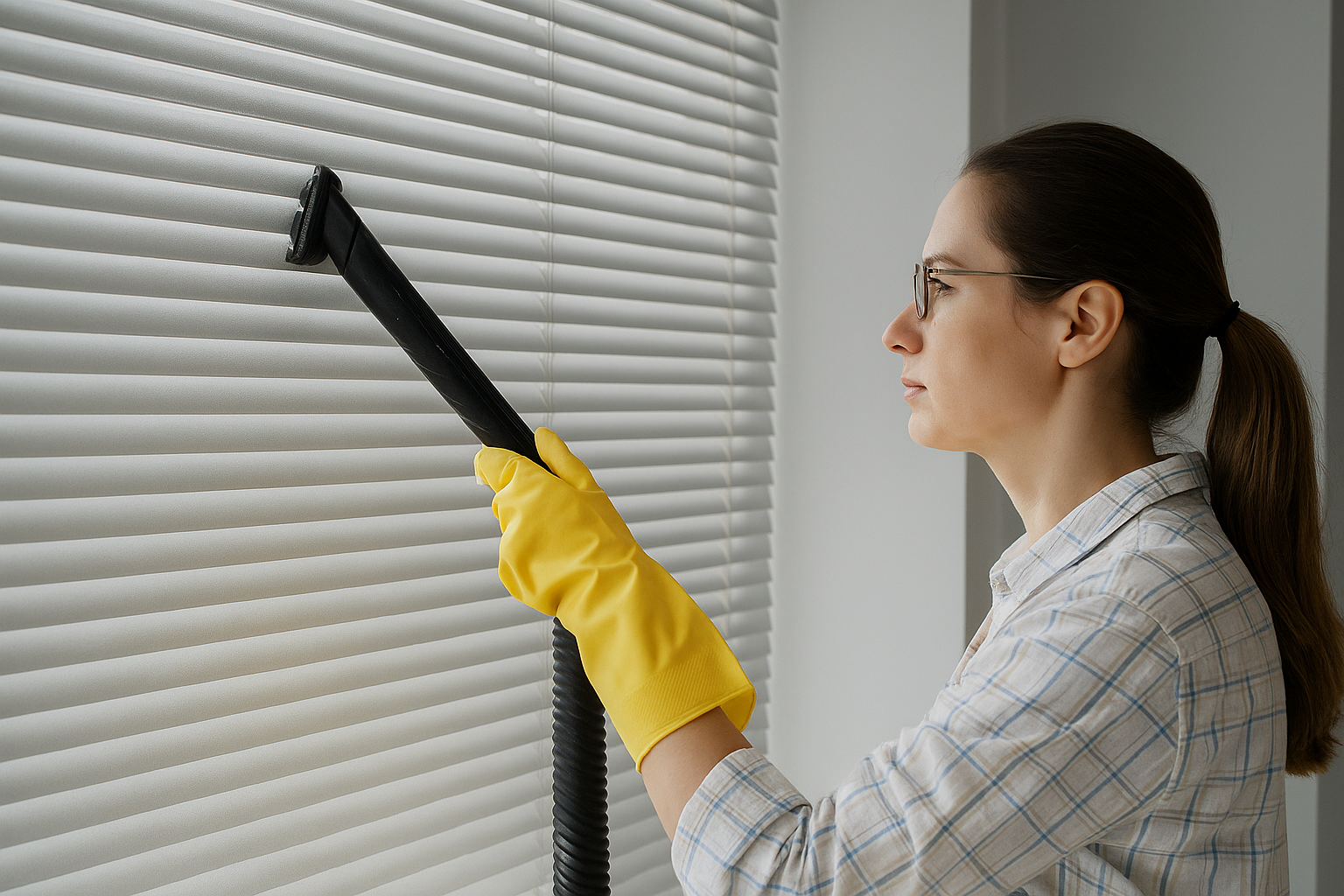How to Keep Your Roller Blinds Dust-Free and Lasting Longer

Roller blinds are a popular choice for many homes because they look neat and are easy to use. They offer a simple way to control light and privacy. But like any other surface in your home, they can gather dust. Keeping them clean not only makes your home look better but also helps with air quality. This guide will walk you through simple, effective ways to keep your roller blinds dust-free, ensuring they stay fresh and functional for a long time.
Understanding Roller Blinds Material
Knowing what your roller blinds are made of is the first step to cleaning them properly. Different materials need different care to avoid damage and ensure they stay looking good.
Polyester Blinds
Polyester is a common material for
roller blinds. It's known for being strong and versatile. Fabric blinds are generally easy to clean, but it's important to be gentle. For regular dusting, a soft cloth or a vacuum cleaner with a brush attachment works well. If you need to spot clean, a mild soap and warm water solution is usually safe. Always test any cleaning solution on a small, hidden area first to make sure it doesn't cause discoloration or damage. When cleaning polyester, avoid scrubbing too hard, as this can damage the fabric. After cleaning, let the blinds air dry completely, unrolled, to prevent water marks or mildew.
PVC and Vinyl Blinds
PVC and vinyl blinds are excellent choices for areas where moisture is present, like kitchens or bathrooms, because they are resistant to water and humidity. Vertical blinds,
roman blinds and venetian blinds have a smooth, non-porous surface also makes them naturally good at repelling dust. Cleaning these types of blinds is straightforward. You can wipe them down with warm, soapy water and a microfiber cloth. For tougher spots or mildew, a disinfectant spray can be used. Make sure to wipe away any excess moisture to prevent streaks and allow them to air dry fully. Avoid harsh chemicals like bleach, as these can damage the material or leave a cloudy residue.
Regular Blind Cleaning Techniques
Regular cleaning is key to keeping your roller blinds dust-free and looking their best. These simple methods can be incorporated into your routine to prevent dust buildup.
Dusting with a Damp Cloth
One of the easiest and most effective ways to remove dust from your roller blinds is by using a damp cloth. A microfiber cloth is ideal because its tiny fibers can pick up and trap dust particles efficiently. Lightly dampen the cloth with water – it should be moist, not soaking wet. Gently wipe down the entire surface of the blind, starting from the top and working your way down. This method is particularly good for everyday dust and light grime. For best results, unroll the blind completely to ensure you clean the entire surface.
Vacuuming with a Brush Attachment
For a more thorough dust removal, especially if your blinds have accumulated a bit more dust, a vacuum cleaner with a soft brush attachment is a great tool. The brush attachment helps to gently dislodge dust without damaging the fabric. Extend your roller blind fully and carefully vacuum both sides. Move the brush attachment in a downward motion, ensuring you cover the entire surface. This method is effective for removing loose dust, pet hair, and other small particles that might cling to the blind.
Spot Cleaning Methods
Sometimes, your blinds might have small marks or stains that require more than just dusting. Spot cleaning routine is the way to go for these isolated areas. Use a mild detergent with a water solution to spray on these stains and after 2 minutes, wipe them properly.
Using Soapy Water
For most common stains, a simple solution of mild dish soap and warm water can work wonders or you can use cleaning sprays. Mix a small amount of dish soap into a bowl of warm water until it's slightly sudsy. Dip a clean microfiber cloth into the solution and wring out any excess water until the cloth is just damp. Gently dab the stained area or general window blinds or wooden blinds being careful not to rub too hard, as this can spread the stain or damage the fabric. Work from the outside of the stain inwards. After treating the stain, use a separate clean, damp cloth with plain water to wipe away any soap residue. Allow the area to air dry completely.
Microfiber Cloths for Stain Removal
Microfiber cloths are not just for dusting; they are also excellent for stain removal. Their absorbent nature and fine fibers help lift stains effectively. When dealing with a fresh spill, immediately blot the area with a clean, dry microfiber cloth to absorb as much liquid as possible. For dried stains, follow the soapy water method described above, using a microfiber cloth for application and wiping. Remember always to use a clean section of the cloth for each wipe to avoid reapplying dirt or spreading the stain.
Deep Cleaning Approaches
While regular cleaning keeps dust at bay, sometimes your roller blinds and panel blinds might need a more thorough clean to tackle stubborn grime or accumulated dirt. Deep cleaning should be done carefully to avoid damaging the blinds.
Eco-Friendly Cleaning Products
For a deep clean, you can opt for eco-friendly cleaning products that are gentle on your blinds and the environment. A popular and effective eco-friendly solution is a mixture of white vinegar and water. Vinegar is a natural disinfectant and deodorizer. Mix equal parts white vinegar and warm water in a spray bottle. Lightly mist the blind surface (after testing on an inconspicuous area) and then wipe down with a clean microfiber cloth. For tougher spots, you can let the solution sit for a few minutes before wiping. Always ensure good ventilation when using vinegar. Mild dish soap diluted in water is another safe and effective option for deep cleaning, especially for polyester, PVC, and vinyl blinds.
Tackling Stubborn Grime
Stubborn grime, like grease marks in a kitchen blinds or mildew in a bathroom, requires a bit more attention. For PVC and vinyl blinds, a disinfectant spray can be used directly on the grime, followed by a thorough wipe with a damp cloth.
For polyester blinds, a slightly stronger solution of mild dish soap and warm water can be applied to the grimy area. Gently scrub with a soft brush or a microfiber cloth. Avoid harsh chemicals like bleach, as they can discolor or damage the fabric. If the grime is particularly tough, you might need to repeat the process a few times. After cleaning, make sure to rinse the area with a clean, damp cloth to remove all cleaning solution residue and allow the blinds to air dry completely.
Preventative Measures
Preventing dust buildup is often easier than cleaning it. By taking a few proactive steps, you can significantly reduce the amount of dust and dirt that accumulates on your roller blinds. Use vacuum with a brush attachment to prevent any damage to your cellular blinds.
Regular Inspection of window shades for Damage
Periodically inspect your roller blinds for any signs of damage, such as fraying edges, tears, or loose threads. Damaged areas can trap dust and make cleaning more difficult. Addressing these issues early can prevent further deterioration and keep your blinds looking cleaner for longer. If you notice any small tears, you might be able to repair them with fabric glue, depending on the material.
Avoiding Harsh Chemicals on Roller Shutter
While it might be good to use strong cleaning agents for a quick fix, harsh chemicals can actually damage your
roller shutters over time. They can strip protective coatings, discolor the fabric, or weaken the material, making it more susceptible to dust and dirt adhesion. Stick to mild, pH-neutral cleaners, or natural solutions like diluted vinegar and mild dish soap. Always test any new cleaning product on an inconspicuous area first to ensure it doesn't cause any adverse reactions.
Maintenance of Operating Mechanisms
The smooth operation of your roller blinds is not just about convenience; it also plays a role in keeping them clean. A well-maintained mechanism prevents unnecessary friction and wear on the fabric, which can otherwise create static and attract dust.
Keeping Chains and Cords Clean
Chains and cords can accumulate dust and grime, which can then transfer to the blind fabric as it rolls up and down. Regularly wipe down chains and cords with a damp cloth to remove any buildup. For plastic or metal chains, a mild soap solution can be used. Ensure they are completely dry before operating the blinds.
Lubricating Moving Parts
If your roller blind mechanism feels stiff or makes noise, it might need lubrication. A small amount of silicone-based lubricant applied to the moving parts of the roller mechanism can ensure smooth operation and reduce wear. This also helps prevent friction that can generate static electricity, which attracts dust. Apply the lubricant sparingly, usually every 6-12 months, and wipe away any excess to prevent it from attracting dust itself.
Enhancing Indoor Air Quality
Beyond just looking clean, keeping your roller blinds dust-free contributes to better indoor air quality, which is especially important for those with allergies or respiratory sensitivities.
Allergy-Friendly Blinds Options
When choosing new roller blinds, consider options that are inherently
allergy-friendly. Smooth, non-porous materials like PVC and vinyl are excellent choices because they don't trap dust, pollen, and other allergens as easily as some fabric options. These materials can be wiped clean quickly, preventing allergen buildup. Some polyester fabrics are also designed to be dust-resistant or hypoallergenic, making them a good alternative if you prefer a fabric look.
Opting for Dust-Resistant Models
Many manufacturers now offer roller blinds with special dust-resistant coatings or materials. These blinds are designed to repel dust, making them easier to keep clean and reducing the amount of airborne particles in your home. While they might be a slightly higher initial investment, the long-term benefits of reduced cleaning effort and improved air quality can be significant. Look for terms like "anti-static" or "dust-repellent" when shopping for new blinds.
Conclusion
Keeping your roller blinds clean doesn’t have to be complicated. With a little regular care like dusting, spot cleaning, and the occasional deep clean, you can keep them looking fresh and lasting longer. Choosing the right methods for your blind’s material not only protects them from damage but also helps maintain a healthier home environment. By taking a few simple steps, you will enjoy blinds that not only look great but also improve the comfort and air quality of your living space.
Ready to work with SYD Blinds & Shutters?
Let's connect! We’re here to help.
Send us a message and we’ll be in touch.
Or give us a call today at 0290-598-262

